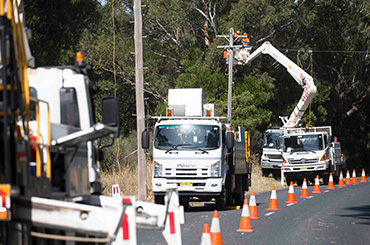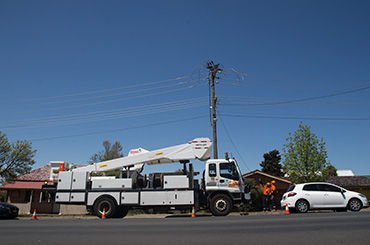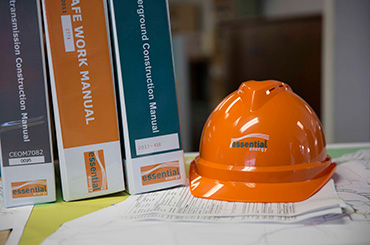
Why move to a SAPS?
It’s reliable. With on-site power generation, these systems are at least as, and often more, reliable than your current network-connected power supply. Additionally due to power being generated and supplied on site, they are considered more resilient in remote, flood and bushfire-prone areas.
It’s tailored to you. Our systems can be designed and built in different sizes so it can be adapted to suit your current and future energy needs.
Solar panels produce electricity from the sun, offering a renewable energy source to supply your power needs.
Our system comes with a lifetime guarantee for repair and replacement, so you can have confidence that it will support your power needs safely and reliably.
Are SAPS systems safe?
SAPS have been installed safely across Australia, and Essential Energy has been successfully installing SAPS as alternatives to grid supply for both residential and commercial premises since 2018.
SAPS are an environmentally safer option, too. Once one has been installed, we will remove the redundant poles and wires and minimise any risk of a network-initiated bushfire and any safety impacts of working around power lines.
How much space does a SAPS take up?
The SAPS solar panels and battery storage units are modular and the size of the system will depend on individual electricity usage requirements. Typically for a standard installation, a SAPS takes up a 10 x 20 metre area.
The system is secured by a fenced enclosure to protect people, livestock and wildlife from electrical hazards, and protect the system itself from theft or vandalism.
Can I choose where the SAPS is located on my property?
Yes, when designing a SAPS we consult with customers and agree on the location, taking into consideration visual and noise impacts, vegetation and other clearance requirements, access and north-facing aspects for solar panels. Generally, SAPS are located between 50 and 100m from residential dwellings.
Will Essential Energy compensate me for the land the SAPS is located on?
This depends on how many properties the SAPS supplies power to. No compensation is paid when a SAPS supplies a single property. When a SAPS supplies multiple properties, compensation will be paid to the owner of the property where the SAPS is located, including costs associated with creating and registering an easement.
Will the SAPS connection be overhead or underground?
The SAPS will use the existing overhead or underground connection in most installations.
In some locations, we may review the existing connection and, if feasible, underground cables will be installed as part of the SAPS installation.
Will a SAPS supply single or three phase power?
Depending on your existing power connection, the system can deliver single (230 volt) or three phase (415 volt) power to your home or other types of accommodation, sheds, workshops, offices and electric vehicles.
Components can be sized to suit your current needs and expanded to meet an increase in power demand.
I have existing solar panels on my roof – can they stay in place and be connected to a SAPS?
Existing solar panels can remain and be used to supply power to a customer’s property.
Exporting solar-generated power back into the network will not be possible once the network connection is removed, so feed in tariffs won’t apply.
If the SAPS generates electricity on site, will my power bill change?
Essential Energy will be trialling alternative tariffs which may lead to a discount off the generation component of a SAPS customer’s electricity bill in the future.
You’ll still receive an electricity bill from your electricity retailer, with energy usage calculated through your electricity meter. Additionally, you can still change electricity retailers to secure the best energy plan.
Will a SAPS damage my electrical appliances?
No, SAPS electricity supply is similar to a conventional electricity network supply – noting that SAPS generates a higher frequency than the Australian electricity grid and this may cause some digital clocks to run slightly fast.
Can a SAPS charge my electric vehicle?
Yes, we can include residential electric vehicle charging in the SAPS design.
What happens if it’s a rainy or cloudy day?
In the event of three or four consecutive days of poor weather, the back-up generator will operate to recharge the system.
What type of back-up generator is used?
A diesel generator is used as the back-up supply to the system. All diesel costs are covered by Essential Energy.
How often does the back-up generator operate?
The system constantly monitors battery storage levels and automatically turns the diesel generator on during prolonged periods of insufficient solar generation and battery charge, then turns it off once the system is recharged. There is no loss of power during change-over so you won’t have to re-set your clocks, and our SAPS are optimised to minimise the generator operating.
The system also schedules the back-up generator to briefly operate every few weeks to ensure its engine and battery are maintained in a serviceable condition.
How noisy is the back-up generator?
The generator will be housed within a canopy or enclosure that keeps noise below 80dB at 5 metres under normal operation. Through our experience with existing SAPS, and verified during our design processes, generators typically run for less than 250 hours per year.
How often will the generator need to be refuelled?
Since the generator only operates as a back-up, Essential Energy will refuel it free of charge every 12 months when undertaking the scheduled SAPS service and inspection.
How will you know when to maintain the system?
We’ll conduct periodic inspections and maintenance, such as cleaning solar panels and maintaining surrounding ground clearances, at no cost to you. Smart communications will also monitor performance and let us know if your system needs servicing or repair by our local area technicians.
Who do I call if I have a power outage?
Call us on 132080. Our Contact Centre operators are available 24/7 to ensure a local area crew will investigate the issue and take steps to restore power.
Is there a cost to install and maintain?
Good news – Essential Energy will pay all costs associated with SAPS installation, operation and ongoing maintenance and we will own the system, just as we do with your current poles and wires.
Who manufactures the SAPS?
Essential Energy works with industry-leading renewable energy companies to purchase SAPS products.
Can I choose to stay connected to the electricity grid?
Yes, upgrade to an independent power system is currently voluntary.
First, we need to determine that it can sustainably meet your current and future needs. Installation will only go ahead if that is the case and you formally agree to the transition.
What if I agree to SAPS installation, then change my mind after you’ve installed it?
Once a customer agrees in writing to upgrade to a SAPS, Essential Energy will invest in buying equipment and designing and installing the upgrade, and it will not be economically viable to reinstate the electricity network connection.
What happens if I sell my property after a SAPS has been installed and powerlines have been removed?
The SAPS will continue to generate and deliver power supply to the property and Essential Energy will continue to maintain full ownership. The new owners of the property will need to create an electricity account with a retailer for their SAPS power supply.
I have solar panels and batteries installed already – can Essential Energy help me move off grid by removing the powerlines from my property?
Essential Energy will remove powerlines that are no longer required. If you are considering moving off grid, or have disused assets call us on 132391 and ask to discuss this with your local planning officer.
Where can I find out more about SAPS?
Contact our Customer Reliability Specialist either by phone on 0269411214 or email via SAPS@essentialenergy.com.au.



